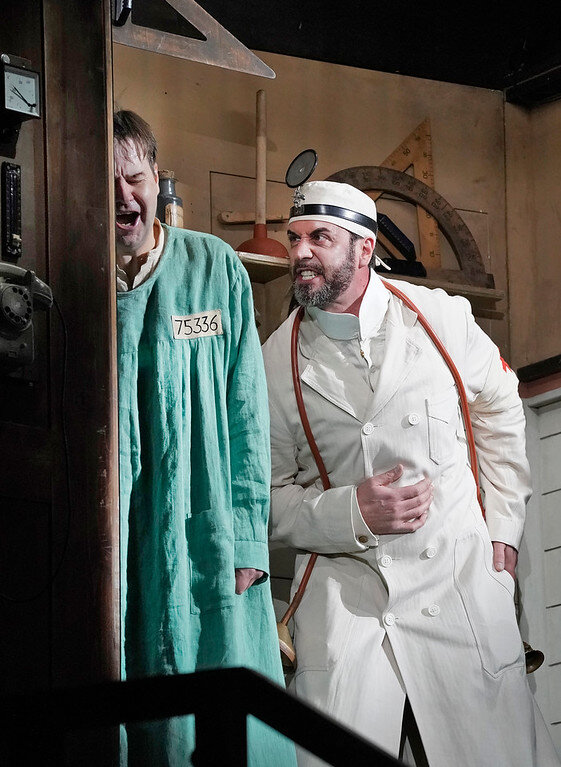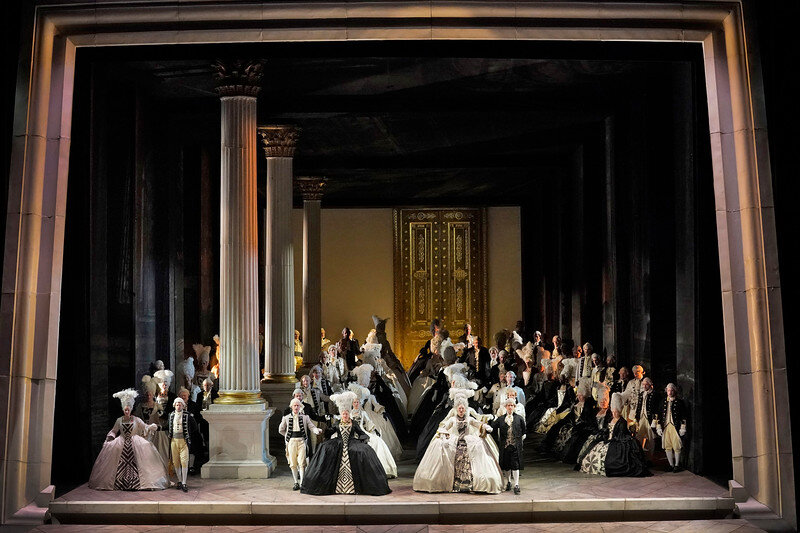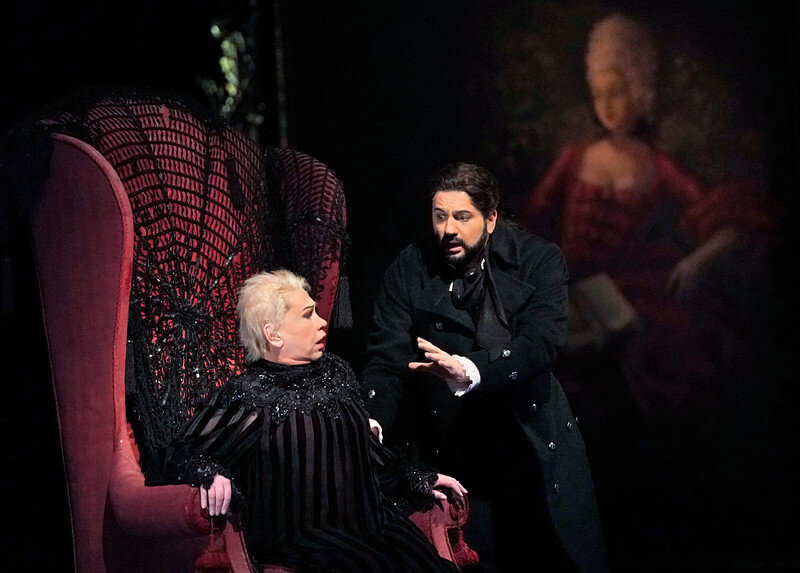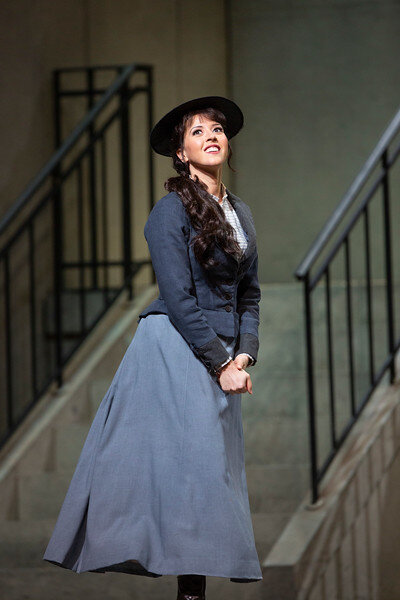Wagner’s Der fliegende Holländer, new at the Met
The Metropolitan Opera’s new production of Der fliegende Holländer, as conceived by François Girard, captures much of the dark mystery of the opera by using modern technology to the fullest. The overture and especially the final scene of the opera are awhirl with waves and storm clouds, courtesy of projections designed by Peter Flaherty and lighting designed by David Finn. They, along with Girard, debuted with the new Met production of Parsifal in 2013. I loved the dark shadows and the clouds then and again now: atmospherically, this Holländer is mostly superb.
Final scene of Der fliegende Holländer: Senta and the Dutchman are soul mates
Anja Kampe, as Senta, sings her Ballad
This production is special, too, because of its Senta, the emotional center of the drama. German soprano Anja Kampe, here in her debut season, is ample in voice, sporting a rich, full, often gleaming instrument. Her stage presence draws our attention in a staging that seems to put a lot of space between characters. Welcome Anja, brava!
Evgeny Nikitin is the Dutchman
The Dutchman is taken by the Russian bass-baritone Evgeny Nikitin, whose contributions to the German and Russian repertory at the Met are broad and always solid. His is the voice type for the darker characters, his Klingsor in Girard’s Parsifal being a case in point. Here the Dutchman seems always at a distance, at one point in the final scene just quietly watching Erik spilling his grief to Senta from across the Met’s wide stage.
German basso Franz-Josef Selig is a positive, not to say jovial Daland (Senta’s father), Mihoko Fujimura is a strict, no nonsense Mary. Tenor Sergey Skorokhodov as Erik gives a most passionate performance, raising our sympathies for his character. David Portillo is a youthful Steersman.
As in all of his early operas Wagner gives much rein to the chorus. Holländer is a case in point: Daland’s crew, their sweethearts back home, and the phantom crew of the Dutchman’s ship are well represented under Donald Palumbo, Chorus Master. As in Girard’s Parsifal, the chorus members are constantly moving, hunching here, fiddling with ropes there, spinning not sails but heavy ropes for the anchors, I suppose, all under choreography of Carolyn Choa. In a way, their movements offset the stasis of the main characters.
Valery Gergiev is no stranger to Wagner at the Met, at home, and throughout the world. He brings out the elements, both of nature and of humans, in this early score, never rushed, but never sagging. Bravo!
Daland and the crew look on as the Dutchman approaches the ship
As found in his Parsifal production, Girard and his team create absorbing and enhancing scenic effects. During the stormy overture an enraptured Senta, alone on the strand at night, communes with the spiritual
force of the Dutchman. He, she feels, is destined to rescue her from the everyday world. Alison Clancy, the dancer in Senta’s red dress, swirls and twists in center stage to Carolyn Choa’s choreography. Effective, but the overture is around eleven minutes long, the point is made early on, then again and again, even though the music of the overture introduces other participants in the drama, Daland’s cheerful sailors, for instance. The opera begins with Daland’s ship coming to a safe haven from the storm, the crew on the strand securing the ropes. Effective entrance! But the arrival of the Dutchman’s ship, an orchestrally bigger moment, is a non-event on stage. Is the phantom ship also invisible? The Dutchman himself merely walks (across the water?) to the rocks at the edge of the orchestra pit where he’ll stand and sing until the scene changes to Act II. As the action is staged, the intensity of the interpersonal relationships are often diffused by the great expanse of the Met’s stage.
Senta is drawn into the Dutchman’s gaze
Review Performance: March 6, 2020, the 161st at the Met.
Photos by Ken Howard
Wagner’s Der fliegende Holländer, as written, is in three acts, but performed as one single act without intermission. It runs two hours and 30 minutes.
Barring closures due to the coronavirus outbreak*, Der fliegende Holländer will appear on the Met stage again on the evenings of March 18, 21, 24, and 27, with a matinee on Saturday, March 14. For ticket information or to place an order, please call (212) 362-6000 or visit www.metopera.org. Special rates for
groups of 10 or more are available by calling (212) 341-5410 or by visiting www.metopera.org/groups.
The Met’s matinee performance of Der fliegende Holländer on March 14 will be telecast live in HD to theaters worldwide and radio broadcast or streamed via various media. It will also be encored in some locations. Information about HD venues, operas, dates, times, casts, and tickets can be found on the
Metropolitan Opera website www.metopera.org. This performance is broadcast on Sirius XM and, locally, the New York metropolitan area, I mean, on WQXR 105.9 FM.
The Met canceled these listed performances the day after I posted the review. It was a necessary decision, given the reality of the spreading virus, but a sad moment in our nation’s history as well as a sad moment for the performing arts, the artists, and the audiences. May the virus pass soon. Stay healthy and be safe.
OM





























